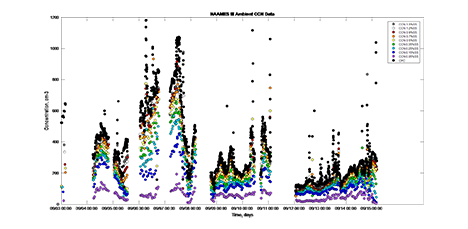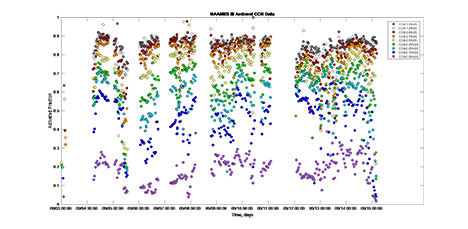Cloud formation depends on several factors, and one of those is the presence of aerosols. Marine aerosols come from a number of sources (sea salt, biogenic aerosols, continental aerosols that are carried over by wind) and differ in size and composition. We’ve collected CCN and CPC data to determine, respectively, the concentration of particles that activate as cloud condensation nuclei at various supersaturations, and the concentration of total aerosols encountered across the RV Atlantis’s path over the course of NAAMES III.
Marine air is relatively “clean” and contains fewer particles per cubic centimeter than continental air. The number of particles changes during certain events: for example, the North Atlantic phytoplankton bloom (the reason we’re all here) may result in an increase in aerosol production. Wind blown in from continents can also increase aerosol concentration. Rain, on the other hand, may decrease aerosol concentration as particles are scavenged by falling water droplets.

Preliminary results for aerosol concentration (CPC) and cloud condensation nuclei concentration (CCN, various supersaturations) for unsized data from NAAMES III.
Our preliminary results for aerosol concentration (CPC) and cloud condensation nuclei concentration (CCN, various supersaturations) are shown above for unsized data from the current NAAMES cruise. The fraction of aerosols that activated as CCN are shown in the plot below. This data also consists of unsized aerosols, so differences in activated fraction could be the result of particle diameter, chemical composition, or both.

Preliminary results for the aerosol activated fractions from NAAMES III.
Over the next few months, we will pair quantitative aerosol data with weather observations, aerosol composition analysis, and biological/oceanography measurements in order to determine why changes in particle concentration and activation were observed over the course of the bloom.
Written by Jessica Mirrielees



